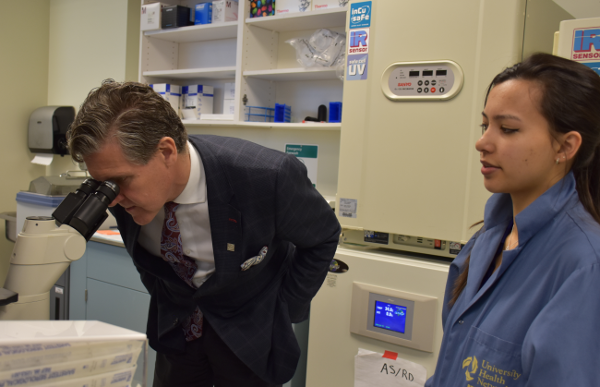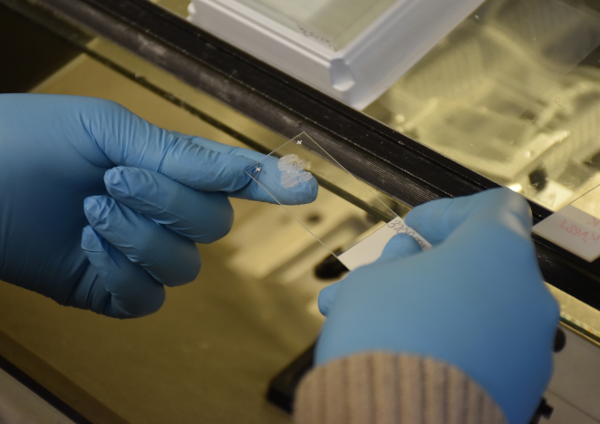How Dr. Michael Fehlings is getting a stem cell cure for spinal cord injury a finger closer to reality
By Nicole Forgione
 Dr. Michael Fehlings has spent his career studying spinal cord injury in the lab, and working with spinal cord injury patients in his neurosurgery practice. He has met and gotten to know many patients — patients like Barbara Turnbull, a journalist and tireless advocate for spinal cord injury (SCI) research who died this past year. Barbara lived as a quadriplegic from the age of 18 when a gunshot wound left her paralyzed from the neck down.
Dr. Michael Fehlings has spent his career studying spinal cord injury in the lab, and working with spinal cord injury patients in his neurosurgery practice. He has met and gotten to know many patients — patients like Barbara Turnbull, a journalist and tireless advocate for spinal cord injury (SCI) research who died this past year. Barbara lived as a quadriplegic from the age of 18 when a gunshot wound left her paralyzed from the neck down.
“Barbara once said that ‘if I could even move my little finger to flick a fly when it lands on my nose, it would mean everything to me,’” says Dr. Fehlings, Krembil Chair in Neural Repair and Regeneration at the University Health Network, and Ontario Institute for Regenerative Medicine investigator.
Talking about success in terms of a motion as simple as flicking a fly puts an entirely new spin on what, until fairly recently, had been the primary goal of SCI treatment: complete repair. Dr. Fehlings believes this is why we still lack viable treatments. “One of the biggest translational obstacles is the perception that we need to have major degrees improvement for things to be worthwhile in patients. Everyone is looking for the homerun, the silver bullet.”
Working with cervical SCI patients like Barbara has galvanized the importance of developing cell-based treatments, even if functional improvements are modest. “The field has been recalibrated to recognize that small differences are important and that they really matter to patients,” Dr. Fehlings explains. “This is one of the reasons we are focusing on cervical spinal cord injury. Regeneration or plasticity across a half a centimeter could result in the reinnervation of the hand.”
With this target in mind, Dr. Fehlings recently led the efforts of our team in preparing an Ontario Institute for Regenerative Medicine (OIRM) Disease Team grant application. As a basic science researcher in the Fehlings group for the past four years I have been involved in many grant applications. I was particularly enthusiastic about working on our disease team grant because of the potential of this funding to take our basic science work in a new direction – to the clinic.
After weeks of work, the night before our grant application was due, emails were flying between members of the grant writing team until close to midnight. We wanted this grant and we were willing to sacrifice a bit of sleep to make sure everything was perfect.
Dr. Fehlings explains why getting this funding was a priority for our group: “This grant allows us to be translationally focused and high risk — it enhances the opportunity for translation of cutting edge therapies, which would not be as attractive to conventional granting agencies. It has enabled us to leverage existing support around our team and bring in new collaborators.”
Spinal cord injury (SCI) affects approximately 1.2 million people in the United States, and 86,000 people in Canada. Individuals with SCI lose the ability to move and sense parts of the body below the level of injury. More than half of all SCI patients sustain injuries to the neck (cervical) region of the spinal cord. This results in some degree of quadriplegia—impairment in all four limbs.
“The reality is that SCI, particularly cervical SCI, is one of the most devastating things that can happen to a human being.” Dr. Fehlings explains that these injuries are so difficult because, “people are cognitively perfect but they can’t control their body. They can’t control their hands and as a result they loose their independence. The simplest things we take for granted like holding a cup of coffee or being able to go to the bathroom independently are gone.”
Caring for SCI patients is also expensive. Lifetime health care costs for the average cervical SCI patient who will live for up to 25 years post-injury can reach $3 million. In Canada, it is estimated the price tag for SCI is $2.7 billion per year. In the United States the costs run into the trillions of dollars. A significant cost driver is the personal support required for patients to accomplish the tasks of daily living. Therefore, decreasing a patient’s reliance on caregivers could directly impact cost.
Apart from standard rehabilitation, there are no treatment options that will improve function, and ultimately quality of life for patients. The regenerative therapies we work on in our lab are not meant to be improvements on or alternatives to existing therapies. Instead, they will be the first ever treatments for SCI.
An inside view of a spinal cord therapy coming together
To achieve the goal of translating a cell therapy for SCI into the clinic we need a team of experts from different fields — stem cell biologists, bioengineers, and clinicians — to design a combinatorial therapy that will give transplanted stem cells the best chance to survive and integrate in the spinal cord.
Spinal cord regeneration is particularly challenging because at least three main cell types are damaged as a result of injury. For spinal cord regeneration to be successful we need the capability to replace: 1) Neurons that relay information via electro-chemical signalling, 2) oligodendrocytes that insulate the long processes extended by neurons known as axons, and 3) astrocytes that help maintain homeostasis in the nervous system.
With the help of stem cell experts Dr. Derek van der Kooy at the University of Toronto and Dr. Andras Nagy at Mount Sinai Hospital, we are developing an approach to coax pluripotent stem cells – master stem cells capable of forming any cell type in the body — into neural stem cells in a dish. We test the ability of these cells to form the neurons, oligodendrocytes or astrocytes by directly transplanting them into our specially developed animal model.
 These experiments are not easy to do. Not only do these studies take special expertise, they are very labour intensive. It takes more than 50 hours of work to reach the point where the cell transplant is complete, but this is only the beginning. To test whether the treatment is having a positive effect on function requires another three months of observation. Following that, we perform hundreds of hours of analysis in the hopes that our transplanted cells have not all died off, or even worse, formed tumours.
These experiments are not easy to do. Not only do these studies take special expertise, they are very labour intensive. It takes more than 50 hours of work to reach the point where the cell transplant is complete, but this is only the beginning. To test whether the treatment is having a positive effect on function requires another three months of observation. Following that, we perform hundreds of hours of analysis in the hopes that our transplanted cells have not all died off, or even worse, formed tumours.
Previous studies from our lab and others have shown that even when everything in a transplantation experiment goes perfectly, there is still only modest recovery of function. After all the blood, sweat and tears that go into completing a study, that’s enough to make you want to hang up your lab coat for good.
But we have learned that one of the reasons for these types of results is that the environment of the injured spinal cord is not hospitable to transplanted stem cells. Just like any other tissue in the body, when the spinal cord is injured it will respond by forming scar tissue. In the spinal cord, this is referred to as glial scarring. The glial scar creates a wall to block off the injured tissue from surrounding healthy tissue, helping to keep the healthy tissue safe. In this respect the glial scar performs an important role, however, it also acts as a barrier to regeneration.
This is where bioengineering expert Dr. Molly Shoichet at the University of Toronto comes in. Dr. Shoichet has devised a biomaterials-based system to deliver the stem cells and specialized enzymes that will break down the glial scar. This approach sets up our cells for success by giving them an environment where they are more likely to survive and thrive. We have enlisted the expertise of Dr. Tator at the University Health Network—a pioneer in SCI research—to test Dr. Shoichet’s innovative enzyme delivery system in animals.
The final component of our therapy is the use of electrical fields to direct the migration of transplanted stem cells. For transplanted cells to survive they must be able to move. Stem cells can do this to a limited extent on their own. Dr. Cindi Morshead and Dr. Milos Popovic, both from the University of Toronto are spearheading efforts to design implantable electrodes that will deliver an electric current that will boost the migration of transplanted stem cells.
Our team is working on a diverse and ambitious set of experiments that we hope will result in moving this therapy into the clinic. One of the biggest challenges is not knowing what the outcome will be in patients. Will the functional outcomes be dramatic or only modest?
As much as we may want the outcomes to be dramatic, Dr. Fehlings reminds us that, “small difference matter.” The movement of a finger may seem trivial, but would be a huge step forward.
